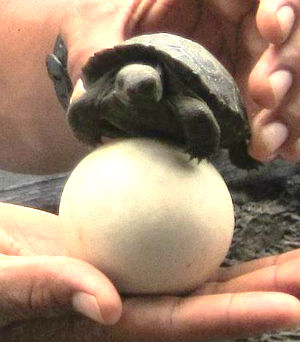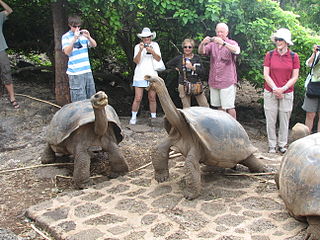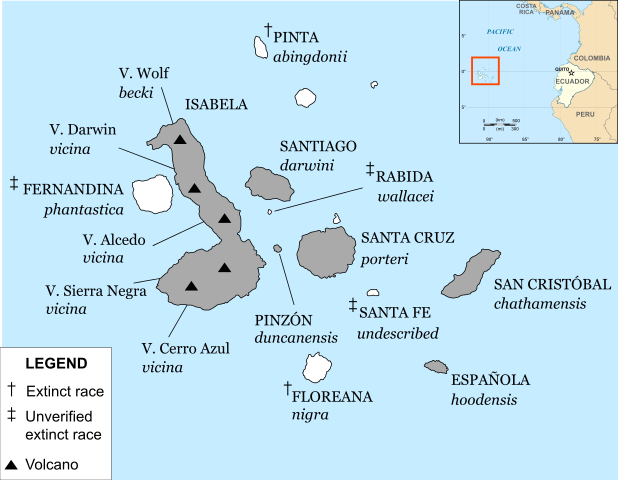Galapagos Tortoise Hatchlings
Baby tortoises found on Galapagos island for first time in 100 years
|
|

Galapagos tortoise hatchling atop egg (Image: Wikimedia)

Tourists viewing giant tortoises (Chelonoidis nigra) at the Charles Darwin Centre, Santa Cruz Island (Image: Wikimedia)
8/31/2015 — Centuries ago, humans inadvertently engineered an environmental catastrophe off the coast of South America. Three years ago, new steps were taken to repair the damage. And those steps seem to be working.
The result is the hatching of baby tortoises in the Galapagos Islands, an event that hasn’t been recorded on Pinzón in more than 100 years.
According to the newsletter The Dodo, researchers spotted 10 tortoise hatchlings in December, but believe there are hundreds more that weren’t found. They estimate that 500 giant tortoises are living on Pinzón Island, which is one of the smallest islands in the archipelago (see map below).
What happened to the tortoise population on the Galapagos?
When sailors landed on Pinzón Island in the mid-1700s, they weren’t the only ones debarking from their ships. Rats also came ashore and found yummy treats in the form of tortoise eggs and hatchlings. They began to gobble up the eggs until, 200 years later, no more Galapagos tortoise hatchlings were ever found on the island.
In the 1960s, when the number of giant tortoises dwindled to 100 and the entire population teetered on the brink of extinction, conservationists gathered tortoise eggs and incubated them on another island. When the tortoises were five years old, workers returned them to Pinzón Island because they were no longer threatened by rats. They thrived, but the incubation didn’t deal with the rat problem.
In 2012, park service biologists dropped poison from helicopters on the island. The poison was targeted only for rats — they devoured it — and Pinzón Island was recently declared rat free.
The Galapagos giant tortoise (Chelonoidis nigra) is the world's largest extant tortoise and the 14th-heaviest living reptile. Strangely, a nearly identical tortoise, the Aldabran Giant Tortoise, exists on the other side of the world from the Galapagos, on Aldabra, a coral atoll off the coast of Tanzania in the Indian Ocean. Galapagos giant tortoises can weigh as much as 250 kilograms (550 lbs). Even larger tortoises of a very similar appearance, once roamed every continent other than Antarctica and Australia. But during the Pleistocene they became extinct everywhere except on Aldabra and the Galapagos, perhaps due at least in part to human predation.
Famously, Charles Darwin's observations of differences among these tortoises contributed to the development of his theory of evolution.
 Galapagos Tortoise distribution map (License)
Galapagos Tortoise distribution map (License)
Most shared on Macroevolution.net:
Human Origins: Are we hybrids?
On the Origins of New Forms of Life
Mammalian Hybrids
Cat-rabbit Hybrids: Fact or fiction?
Famous Biologists
Dog-cow Hybrids
Georges Cuvier: A Biography
Prothero: A Rebuttal
Branches of Biology
Dog-fox Hybrids
